5 Bumble bee Foraging Favourites
What did the bee say to the sunflower? “Hello honey!”
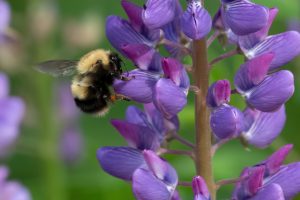
Foraging is an important daily task for busy bumble bees. Bumble bees leave the nest early in the morning and spend most of the day foraging for nectar and pollen from plants, pollinating as they go about their rounds. Bumble bees are such efficient pollinators that some flowering plants have evolved to exclusively be pollinated by these loveable insects.
Bees forage on plants for both their nectar and pollen resources. Pollen contains the necessary proteins to help bees grow and nectar is a source of water and sugar which is an important part of every bee’s diet.
As expected, the plants that bees forage on flower at different times of the year; therefore, bees have to shift their foraging preferences as the season wears on. In early June, you might find bumble bees foraging on red clover whereas in July they may prefer to forage on fireweed even though red clover is still present.
Every species of bee has different foraging preferences and this all depends on their unique anatomy including factors such as the bee’s size, weight, and length of their tongue (also referred to as a proboscis). Each species of bee also has a unique foraging range. Some bees prefer to forage closer to their nests where other bees forage kilometers away from their home base. All of these preferences have evolved in each species over several generations as they have adapted to the world around them. In this chapter, we will discuss ten different types of flowers that you can find bumble bees on in Cape Breton so that you can go out and find bumble bees in your neighbourhood.
Fireweed (Genus Chamaenerion)
Fireweed is a genus of flowers known as Chamaenerion. These brightly coloured flowers are a favourite of the yellow-banded bumble bee, a COSEWIC Species of Special Concern. Fireweed blooms from July to September with peak flowering times from mid-July to early August.
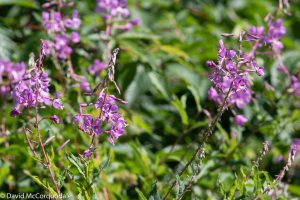
How to identify: Fireweeds have bright purple or pink inflorescence (a cluster of flowers that branch out from the main stem) that extend from a tall woody stem. Their leaves wrap around the entire stem in a spiral pattern that extends from the base of the plant up to the flowers.
White sweet clover (Melilotus albus)
White sweet clover is not a native species to Cape Breton as it was introduced to North America by humans. You can commonly find these plants along the side of roads, near soccer fields, playgrounds, or other unnatural outdoor habitats. Flowers can start appearing in May and some plants can flower until mid-October.
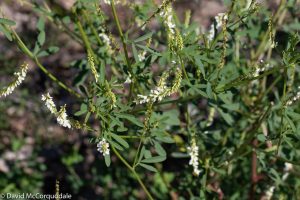
How to identify: These small, white flowers can form clusters up to 20 cm long along the length of the plant’s stem. The plant has a compound leaf arrangement which means that the leaves are grouped together and contain more than one leaflet. The leaves themselves are toothed and they alternate along the stem.
Black Knapweed (Centaurea nigra)
This non-native species arrived in Cape Breton from Europe after settlers arrived in Unama’ki. Like white sweet clover, black knapweed can be found in man-made environments such as along the sides of roads and in fields.
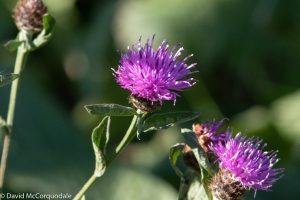
How to identify: These bright purple flowers emerge from a smooth green stem that has an alternating leaf pattern. The leaves of black knapweed are lobed and not separated into leaflets. The purple flower head has what we call disk flowers. This means that the flower head itself contains many individual tiny flowers that make up the entire head. Black knapweed is very hardy and therefore you can usually find it in bloom from June until as late as November.
Goldenrod (Genus Solidago)
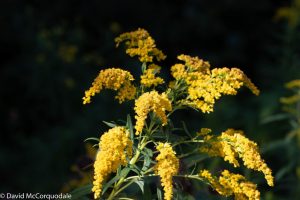
The genus Solidago contains several different species that bumble bees love. Canada goldenrod, rough-stemmed goldenrod, and northern seaside goldenrod are just a few species of goldenrod that you might find bumble bees foraging on.
How to identify: Goldenrods have bright yellow disk flowers and ray flowers (a single, long petal that extends from the flower head) that branch out at the very top of the plant’s tall stem. The lobed leaves alternate up the length of the stem. You can usually find goldenrod in bloom in large numbers in meadows and fields from mid-summer to early autumn.
Tufted vetch (Vicia cracca)
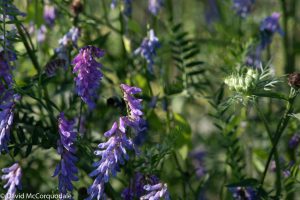
These bright purple flowers are a member of the pea family and therefore, before they are in bloom, you may notice small pea pods on the plant. Like peas, these plants climb other plants and structures around them using their long tendrils to cling to their surroundings. You may also know this species as cow vetch which is another popular name for this species.
How to identify: These small tubular-shaped flowers are nestled on one side of the raceme and are normally bright lavender or blue in colouring. A raceme is a flowerhead that contains individual flowers that run along a strand of the plant. The compound leaves of this plant are a grey-green colour which have about 8-12 leaflets in each compound leaf. Tufted vetch is normally in bloom from early June to late August.
Red clover (Trifolium pratense)
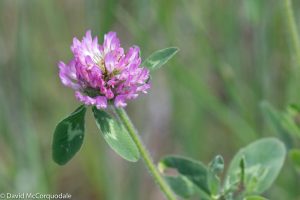
Red clover is also a member of the pea family and therefore they share many of the same characteristics of tufted vetch. This non-native species is a favourite for bumble bees with longer tongues as those bees have the ability to drink nectar from the long, tubular shaped florets.
How to identify: the head of the flower is quite densely packed with magenta, tubular florets. The leaves are characteristic of clovers which contain three leaflets per composite leaf. The leaves are mostly green with a white v-shaped marking. These plants are a resilient species that are tolerant to cooler temperatures therefore you can find them in early spring until late October in some places.
Canada thistle (Cirsium arvense)
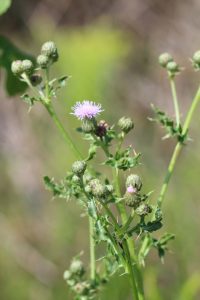
Contrary to what the name might suggest, Canada thistle is actually a non-native species. In other countries, it is more commonly referred to as creeping thistle. These plants are very prickly so if you are looking for bumble bees around them, be careful!
How to identify: Canada thistles have pale lavender coloured flower heads with disk florets (similar to the disk florets we discussed previously in black knapweed). Their stems are smooth and highly branched and the plant itself can grow as tall as 150 cm. The leaves are green, sharply toothed, and have small tiny hairs that run along the length of the stalkless leaves. You can usually find these large plants in bloom from July to September.
Common St. John’s wort (Hypericum perforatum)
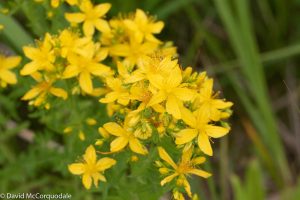
These vibrant flowers are not only a favourite among bees, but they have also been known for their uses in traditional Mi’kmaq medicines.
How to identify: These bright yellow flowers branch out from a plant that can grow to be upwards of 75 cm in height. Each flower has five petals with long stamens that extend upwards from the center of the flower. A stamen is a long, reproductive component of a flower that contains pollen at the very top of it. The leaves of this plant are long, rounded, and have small translucent dots on them. They are also arranged in an opposite formation. This means that the leaves are directly opposite from one another along the length of the stem. You can find common St. John’s wort in flower from July until September.
Roses (Genus Rosa)
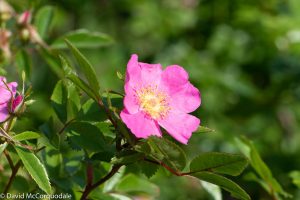
Roses in general are very popular among bees. They come in a variety of shapes, colours, and sizes and can be found along shorelines, in forested areas, and even in your own backyard!
How to identify: Rose bushes can grow very large and they contain clusters of flowers each with 5 petals. Their leaves are sharply toothed compound leaves. Wild roses in Cape Breton are usually a light pink or white colour. Roses usually have sharp and prickly thorns along their stems so be mindful when looking for bees around them. You can usually find them in flower from early summer until September.
Queen Anne’s Lace (Daucus carota)
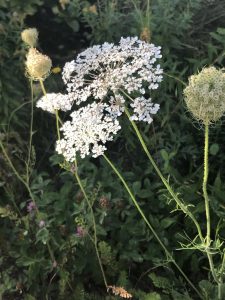
Also known as wild carrot, Queen Anne’s lace is commonly found in fields and along roadsides. These flowers are not usually the first choice for bees, however, in areas where no other foraging favourites are available, bees will forage on Queen Anne’s lace if necessary.
How to identify: These white flowering clusters are flat at the top and can grow as tall as 90 cm in height. The leaves of Queen Anne’s lace are compound, triangular-shaped, and finely toothed giving them an almost fern-like appearance. The leaf pattern alternates along the length of the stem. You can find these flowers in bloom from early summer to mid-autumn.
Let’s put what we have learned thus far to the test. In this matching quiz, can you identify the species or genus of flower in each photo?
The action of a bumble bee gathering pollen and nectar.
The transport of pollen from one plant to another is a major part of a plant's life cycle. While foraging, pollen brushes onto bumble bees and as they fly from flower to flower of the same species, they fertilize the plants as they go. Plants that are pollinated can produce seeds which means more plants will grow. For more information visit The Eden Project.
The tongue of a bumble bee used to drink nectar from flowers.
Committee on the Status of Endangered Wildlife in Canada who are responsible for determining if a species is at risk.
The complete head of a flower which is sometimes made up of multiple flowers that extend from a stem.
A single leaf that is made up of multiple leaflets as the blade of the leaf is divided into a collection of smaller leaves.
A species that has been introduced to an area that is not within its natural range by humans. Can also be referred to as an invasive species in some circumstances.
Tiny tubular-shaped florets that makeup one portion of the flowering head. They often form the center or eye of the flower.
The petals of a flower.
A flower head with individual flowers that run along the side of the plant.
A single leaf that is made up of multiple leaflets as the blade of the leaf is divided into a collection of smaller leaves.
One part of a flower that makes up the entire flowering head.
The male part of the flower which extends upwards from the center of the flower and is covered in pollen.

